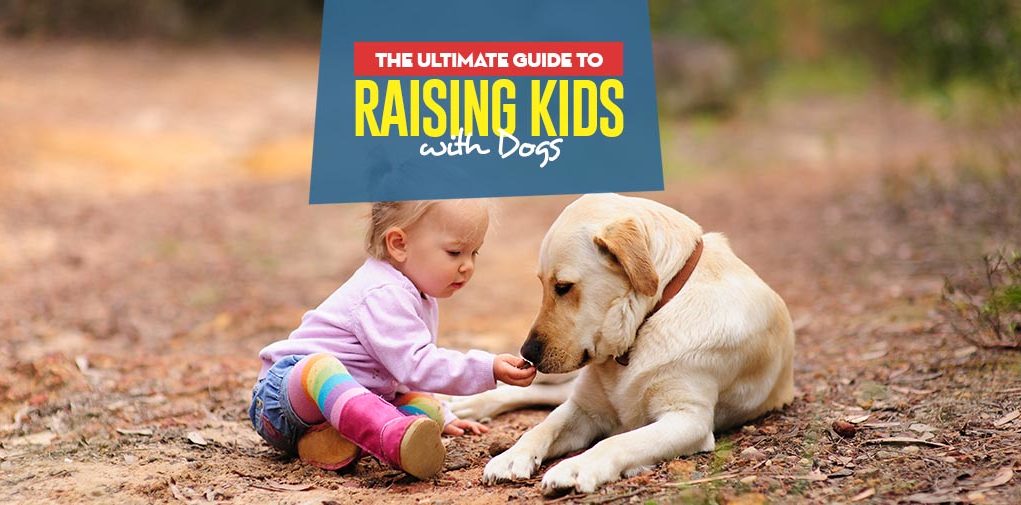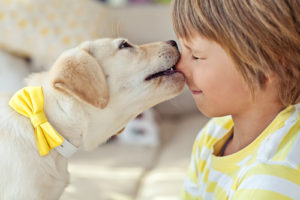Raising kids with dogs is beneficial for both the child and the dog. However, to be successful, it must be done correctly. Unfortunately, there are many parents that do not spend the time (or have the time) to understand how to raise kids with dogs, and vice versa. This often results in children getting bitten and dogs being sent to shelters.
Tons of research has shown the benefits of raising kids alongside dogs for every party involved: the kids, the dogs and the whole family. We know kids are less stressed when there's a dog at home, dogs help children thrive and improve health of young kids; children also have a great companion in pets among the many other benefits.
But if you're planning on raising your kids with dogs, you need to start with proper dog training. And, the training isn't just for the dogs. Children need to be taught how to properly behave around dogs, and dogs need to be trained to behave around children.
This guide will explain how to teach children and dogs to live in harmony. It's your job as a responsible parent and pet owner to put the time and effort into working with your pets and kids together. It won't be easy at first, but it will be well worth your time in the end.
To start you off, here are a few quick video and written guides for parents with dogs:
Scientific evidence on the benefits of raising kids with dogs
You may be thinking that it would be easier to raise your children without dogs. While it may be easier, there are a lot of physical and emotional benefits to raising kids with dogs, some of which I've already linked to above.
More studies are coming out and showing that there are serious health benefits associated with with have pets – and dogs in particular – around your home when raising kids from their infancy.
For example, this another study done by the University of Wisconsin's Department of Pediatrics shows a correlation between newborns exposed to canines in their home and a reduced rate of allergic diseases such as atopic dermatitis.
Other researchers have focused on the overall health benefits that can be correlated to kids being raised with dogs in the same household. It has been shown that children who have a dog in the family are more active. This additional physical activity leads to a lower chance of obesity among kids (and, subsequently, dogs).
There was further research on this, and a similar study found that children with a variety of disabilities are more active when raised with a dog. Physical activity aids in respiratory and cardiac health of kids. Staying physically fit also reduces the chances of contracting many diseases linked to obesity, including diabetes and asthma.
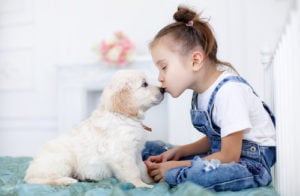 In addition to physical health benefits, it has been proven that pets reduce a child's stress and anxiety levels in most cases. While this can be beneficial to children with stress and anxiety disorders, it can also help children who are ill and spend a lot of time in hospitals and children who experience physical or emotional abuse.
In addition to physical health benefits, it has been proven that pets reduce a child's stress and anxiety levels in most cases. While this can be beneficial to children with stress and anxiety disorders, it can also help children who are ill and spend a lot of time in hospitals and children who experience physical or emotional abuse.
Furthermore, there are even studies that show that reading to dogs helped improve a child's fluency and reading skills simply by encouraging them to read more.
I've only scraped the surface of all the available data on the benefits of raising children with pets, and dogs in particular. There's a lot more to this. And with the above in mind, it's safe to say that raising kids with dogs will benefit both parties in countless ways.
Now that you're aware of how beneficial it can be to raise kids with dogs and that you shouldn't give up your dog before having a child, let's talk about how to work with your family (both two- and four-legged) to make the experience advantageous for everyone.
ALSO READ: 14 Safety Tips for Adopting a Dog When You Have Kids
The Ultimate Guide for Raising Kids with Dogs
17 Things Every Parent and Dog Owner Must Know
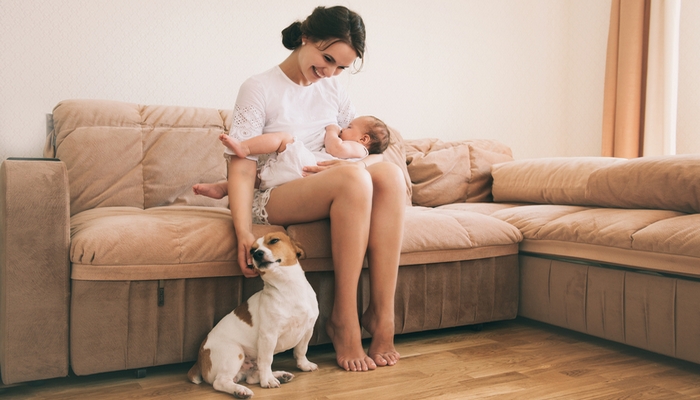
First, I'll share a few tips that have helped millions of parents bring furry children into their home. These tips will help you to teach your pet and your child how to interact in a safe manner that will benefit them both. I've learned this from talking to dog trainers who are also parents, and was able to collect tons of valuable advice from these professionals.
Now, here are my 17 tips to assist you when raising kids with dogs in your household:
1. The Importance of Basic Training
Obedience training gives your dog a framework by which they can interpret the world around them. It teaches your dog what is expected of them, how to act, and how to communicate.
For example, redirecting a dog that engages in rough play lets them know that this is undesirable behavior. Conversely, rewarding desirable behavior encourages repetition of this behavior. A solid basic training foundation makes your dog confident and less likely to react poorly to new situations like the arrival of a baby.
For a little more in-depth tips and advice on specific areas of dog training and children, check out our expert interview on whether kids should get involved with dog training.
2. Socializing Your Dog with Children
Socializing your dog with children is just as important as socializing them with adults and other dogs. Even if you are not planning on raising kids with dogs, it’s crucial to expose your dog to children to prevent fearful behavior. Science has shown that early socializing of your dog will reduce chances of aggression in the dog as he gets older.
Begin desensitizing your dog to children by walking them in areas where children are present. As your dog becomes more confident, get closer to the children. This exposes your dog to different sound and movement patterns.
When you are confident in your control of your dog and in their ability to safely interact with children, invite children to pet your dog. Do this by putting your dog in a “sit” position and instructing children how to properly approach and pet your dog.
3. Include Your Dog in the Pregnancy
Include your dog in your pregnancy to make them feel like part of the family. This doesn’t just make your dog feel “wanted” but it also lets them bond with your new baby even before birth.
If you shun your dog during your pregnancy, he may become resentful. Your dog may also experience so much isolation that they will vie for your attention by behaving badly.
4. Expose Your Dog to the Sounds of a Baby
While your dog can sense that you are pregnant, they will not be familiar with the sounds of a new baby. Help your dog to adjust by playing a recording of baby sounds.
Expose your dog to these sounds gradually, playing a few minutes at a time and rewarding your dog when they react positively. Be sure to include as much variety in sounds as you can!
- RECOMMENDED READING: 10 Best Books for Dog Owners with Kids
5. Teach Boundaries
 If your dog is not already familiar with boundaries, it’s a good time to begin teaching them. Take time to enforce rules about personal space as well as any physical boundaries in the home that you don’t wish them to cross.
If your dog is not already familiar with boundaries, it’s a good time to begin teaching them. Take time to enforce rules about personal space as well as any physical boundaries in the home that you don’t wish them to cross.
For example, many dog parents choose to limit their pet’s access to the new baby’s room.
6. Expose Your Dog to Your Baby’s Scent
Once your baby is born, expose your dog to the new baby’s scent before the baby comes home. Do this by bringing a hospital blanket that has been used to swaddle your baby home.
Allow your dog to smell the blanket and thoroughly get the scent of your new baby. Repeat this introduction over the days before your baby comes home so that your baby’s smell is familiar to your pup.
7. Monitor ALL Interaction
New parents often monitor every interaction between their baby and their dog, but as their baby grows, they become lax. Fear aggression in dogs is a real thing, and it's especially important familiarize yourself with how it manifests itself in canines.
Whether your child is a new baby or a toddler, you should always monitor all interaction between your dog and your child to prevent miscommunication or frustration.
Failure to monitor interactions when raising kids with dogs can result in growling, nipping, or biting as your dog is startled or pushed to “correct” a misbehaving child.Remember, dogs don't communicate the same way that we do. When Fido needs to ask your child to stop doing something, he will do so with a growl or bite.
8. Teach Your Child How to Interact With Your Dog
From a very young age, it’s important to teach your child how to interact with your dog. This means teaching your child how to approach your dog, when to approach your dog, when to back off from a dog, how to behave around your dog, and how to interpret your dog’s body language and different behavior.
Teaching young children how to interact with your dog is as simple as telling your child “No! Don’t do that!”. As your child ages, however, you can teach them the why’s and how’s of interaction.
A great tool for teaching children how to interact with and understand dogs is through your example. Online videos can also prove to be great teaching tools. Just as well, there are several commands you will need to teach your dog as well as right after adoption.
9. Maintain Structure
When a new baby comes home, the entire structure of the household changes. As a creature that thrives on structure, your dog is likely to become confused or even irritated with this change.
To make the transition easier for everyone, try to maintain as normal of a schedule as possible. If you always fed your dog at 8 am, make sure that you still do this when raising kids with dogs. If you always walked your dog at 7 pm, ask your spouse to watch the baby so you can walk.
10. Consider the Age of Your Child
When you have children and you are considering bringing a new dog home, consider the age of your children.
Ask yourself the following questions:
- Is your child old enough to understand how to interact safely with a dog?
- If you want a puppy to grow up with your child, are you prepared for the responsibility and demands of both?
- Does your child have any behavioral concerns that may pose a threat to your new pet?
- Do your children require so much of your time that you won’t have time for a dog?
- Can your children help with chores involved with taking care of your dog?
- Is the size of dog you are considering compatible with the size of your child?
- Is the energy level of the dog you are considering compatible with your child and with your lifestyle?
11. Teach Your Child How to Behave Around Animals
If you are certain that you and your child are prepared to add a dog to your home, teach your child how to behave around animals first. A good way to do this is by taking your child to the home of a friend with pets.
If you don’t have friends with pets, visit a petting zoo instead. This will let you teach your child how to approach and touch animals as well as how animals react to them.
When doing this, it’s also important to point out what not to do. For example, if a dog is eating a treat, you may say to your child “how do you think the dog would feel if you took his treat away?” When the child responds that the dog would be upset, tell them that this is exactly why you should not take his treat away.
Highlight the following points:
- Just like you don’t like being startled, a dog doesn’t either
- Don’t ever wake up or approach a sleeping dog
- Don’t ever take food from a dog
- Dogs have emotions just like we do
- Don’t tease dogs
- Never run away from a dog you don’t know, instead, back away slowly
- Never run towards a dog even if you know them
- Always ask before approaching or touching dogs
RECOMMENDED: 16 Best Dogs for Families with Kids
12. Talk to Your Child About Canine Body Language
If you have the chance to expose your child to a dog, point out the body language of the dog. If you do not have the chance to expose your child to a dog, use pictures, and online videos to explain different types of body language and behaviors in dogs.
It’s important to highlight the following tips when raising kids with dogs:
- Tails wagging doesn’t always mean that a dog is happy
- A dog with their ears back is likely afraid and should be left alone
- Showing teeth is a sign to back away
- Growling is a sign to back away
- Barking is how dogs communicate
- Eye contact can be scary for dogs you don’t know
13. Expose Your Child to Dogs
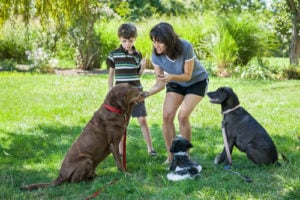 If you haven’t had a chance to expose your child to dogs yet, make sure that you do before you bring one home. Too many parents find out that their child is terrified of dogs or doesn’t know how to behave with them until they bring one home. This almost always results in the dog being taken to the shelter.
If you haven’t had a chance to expose your child to dogs yet, make sure that you do before you bring one home. Too many parents find out that their child is terrified of dogs or doesn’t know how to behave with them until they bring one home. This almost always results in the dog being taken to the shelter.
If you do not have friends with dogs, contact a local shelter or breeder and ask if they would be able to assist you. Most shelters and breeders will be happy to help you to educate your child.
14. Allow Your Prospective Dog to Approach Your Child
Before bringing a new dog home, expose your child to dogs for a minimum of a few weeks. After this, if you have chosen a prospective dog, introduce your child to the dog. It is best to do this at a shelter or a breeder’s home.
Allow the dog to initiate contact with your child and not the other way around. This lets the dog set the tone of their interaction and prevents your child from overwhelming the dog.
RELATED: 11 Interesting Dog Facts for Kids on Canine Behavior
15. Include Your Child in Your Dog’s Training
When you are sure that your child and dog can get along, it may be beneficial to include your child in your new dog’s training routine. However, this is tricky subject, and I recommend you read the expert interview I've linked to above.
But in general, involving your kid in dog training helps your child to understand how to communicate with your canine companion and helps your dog to view your child as more than an equal. General dog training is also a good opportunity to teach your child about responsibility and how his actions may affect others.
16. Model the Behavior You Want Your Child to Show
One of the most important things that you can do as a parent is to model the behavior that you want your child to exhibit with your dog.
Remember to be kind, be patient, be compassionate and be confident.
17. Give Your Child Responsibilities
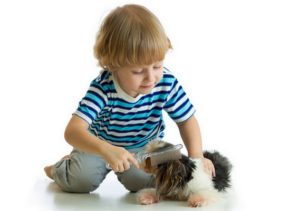 In addition to including your child in your dog’s training, give them age-appropriate responsibilities. Doing this helps your child to bond with your dog as well as respect what it takes to care for a dog.
In addition to including your child in your dog’s training, give them age-appropriate responsibilities. Doing this helps your child to bond with your dog as well as respect what it takes to care for a dog.
Some responsibilities you may consider giving your child include the very basics of dog care:
- Feeding your dog
- Walking your dog (only older children)
- Picking up after your dog
- Playing with your dog
- Washing your dog
- Washing your dog’s bowls
- Brushing your dog
ALSO READ: 21 Useful & Free Resources for Dog Owners with Kids
With these 17 tips on how to raise kids with dogs out of the way, here are a few things you must keep in mind and that will foster a much healthier relationship in your home.
When Raising Kids with Dogs You Should ALWAYS…
When raising kids with dogs, there are a few things that you should always do to ensure the safety of all of your family members.
You must remember to:
- Always supervise your child with your dog
- Always reinforce the importance of personal space
- Always emphasize how your child is making your dog feel
- Always remind your child to be aware of their dog’s mood
When Raising Kids with Dogs You Should NEVER…
When raising kids with dogs, there are also a few things that you should NEVER do in order to ensure their safety.
Make sure to never:
- Never let your child climb on or “ride” your dog
- Never let your dog “babysit” your child
- Never let your child hit, pull at, or otherwise bother your dog
- Never let your child pick up or carry your dog
- Never let your child dress up your dog or treat them as a toy
- Never let your child tease your dog
- Never let younger children walk your dog even with supervision
RELATED: Essential Dog Products for Dog Owners with Kids
What to Do When?
If you're raising children and dogs together, you're going to have a lot of questions throughout the process. Things will happen that will completely catch you off guard and probably make you very nervous.
I'll try to answer some of these frequently asked questions. If you ever have a question about your dog's behavior, be sure to consult your veterinarian or a professional dog trainer.
Only professional and experienced dog trainers will be able to give you the most accurate advice and explain why your dog is acting the way he is and how you can correct the issue.
Now, here are a few things I've learned from professionals that I will now relay to you:
1. When your child exhibits inappropriate behavior with your dog
When raising kids with dogs, this is bound to happen. Correct your child immediately. If he repeats this behavior, consider consulting a trainer to work with your child and your dog together.
If your child’s behavior becomes dangerous, immediately remove your dog from the situation and seek professional assistance with your child’s behavior.
2. When Your Dog Exhibits Aggressive Behavior
An aggressive dog should always be separated from children. It is also important to try to determine why your dog is showing aggressive behavior. Health conditions may cause aggressive behavior, but they can often be treated.
Provoking can cause aggressive behavior and should be addressed as noted above. Behavioral experts may also be able to assist in training and working with dogs exhibiting aggression. In cases of extreme aggression where a dog cannot be rehabilitated, euthanasia may be the only solution.
3. When Your Child Wants to Take Part in Age Inappropriate Responsibilities and Activities
 If your child wants to take part in age inappropriate tasks and responsibilities related to caring for your dog, do not give in. Instead, find age-appropriate tasks that will keep your child and dog safe.
If your child wants to take part in age inappropriate tasks and responsibilities related to caring for your dog, do not give in. Instead, find age-appropriate tasks that will keep your child and dog safe.
In Summary
There are plenty of uncertainties in raising children and in raising dogs, but the key to your success lies in your confidence.
If you are confident, your child and your dog both will be confident in your position as their parent. If you are uncertain, find confidence through consulting a professional trainer or behaviorist.
READ NEXT: 35 Best Medium and Small Dogs for Kids


